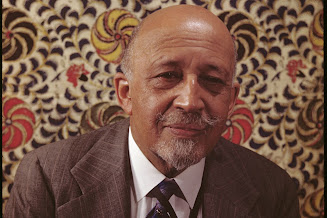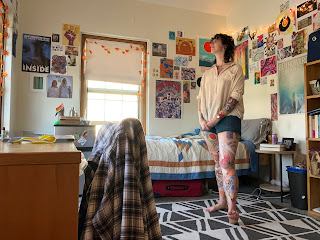I spent the majority of the weeks discussions focused on the bell hooks reading because I think it is easier for us to look for problematic things to call out about a white person's representation of black culture than to try to find some nuance in the effects of that representation. bell hooks' writing is also just extremely compelling, as someone said in class, which probably has a lot to do with why we were all so drawn to it. Regardless, I want to try to focus on aspects of the Goldsby article that I found most sparked interest and conversation in me.
One thing I was drawn to was Goldsby's discussion of how the children transformed the idea of the "veil". In another one of my classes, I just read the excerpt of The Souls of Black Folk in which W. E. B. Du Bois first presents the idea of the "veil". He used it to create an idea of double consciousness. Black people are segregated from white society and culture by a veil, which creates in them two identities; one of being black, and one of being American.

Black people are not allowed or accepted by white society to be both, and so are constantly pulled in each direction by opposing forces. Du Bois however says the black person's greatest struggle is refusing to choose between the two. He says the black person “would not Africanize America, for America has too much to teach the world and Africa. He would not bleach his negro soul in a flood of white Americanism, for he knows that Negro blood has a message for the world” (page 689 of the Norton textbook I'm using). I think the intention behind this is rooted in the early lofty ideals of America as a refuge and new start for unwanted people all over the world. Obviously, this was never and continues not to be true (the history of U.S. immigration policy being the primary evidence), but Du Bois found value in the hypothetical idea of it at the time. His suggestion that black people have a lot to offer suggests his awareness and critique of American and worldwide white supremacist and settler-colonialist ideas.
So, how does this tie into Goldsby? Goldsby says of the black and brown queer folks in Paris is Burning that “In a truly Grand Diva move, the children restitch the veil to mean something other than socially imposed, self-abnegating denial, since, in the ball world, veils allow illusion, which allows self-expression, which allows self-fulfillment” (113). I'm curious about this because it seems to voice the tension a lot of us feel about drag and ball culture, particularly as it is portrayed by Livingston. The clear separation of the black, brown, and queer folk in the film from the majority white female stars they idolize would seem to make their performance and attempts to become as white and feminine as possible an attempt to "bleach" their black and brown souls. However, Goldsby finds liberation and self-satisfaction in these actions as a queer person of color, and I can't help but want to empathize with and appreciate that.

So what do they mean by saying the children's use of the veil allows self-fulfillment? Let's consider art as a form of expression, through which we can purge our struggles and share how we see ourselves on the inside. If the dance and costuming involved in ball and drag culture are seen as art, they become clear and profound ways of expressing those things that dominant white and heteronormative culture suppress. I think this is what Goldsby is trying to get at. The children of the houses depicted in the film are taking exactly what oppressed them and using it as a way to free themselves. Goldsby mentions Livingston maybe once or twice in her entire article. While Livingston's white gaze clearly pollutes every aspect of Paris is Burning, as we well learned from hooks, Goldsby refuses to give her the satisfaction of making their article about her. This could be seen as ignorance, but as a black queer person Goldsby I think has a right to choose to exclude Livingston from their analysis. They choose to focus instead on the queer people, who exist on screen no matter how much Livingston tries to distort them.
I think we should all be rightfully skeptical of this entire film because of its creators, just as we should be skeptical and even critical of RuPaul's Drag Race and Pose. I personally am still not overall convinced that the effect the film has had on the world (particularly on the lives of black and queer people) was at all positive, in fact, I think it has done far more harm than good thanks to Livingston (see my super depressing Moodle Forum post). I just wanted to bring Goldsby into the conversation and acknowledge their analysis and focus on the black and brown queer people in the film, who, at the end of the day, are way more important than Livingston's white supremacy. Is it helpful and maybe even important to shift the conversation to focus on those people and give Livingston less power than she already has as the filmmaker?
I'm curious to see what y'all think.
Madeleine




Honestly thank you so much for writing this! I know this perspective was shared in class but I didn't have a great overall understanding of it all, you explained it very well!! While watching Paris is Burning I didn't feel pity for the performers, like some peers mentioned, but I didnt see their costuming as art in the vibe of self-expression and liberation. I def agree that it makes for a better conversation if there is less focus on Livingston and shine more light on the actual people who allowed their culture to be shared with the world.
ReplyDelete